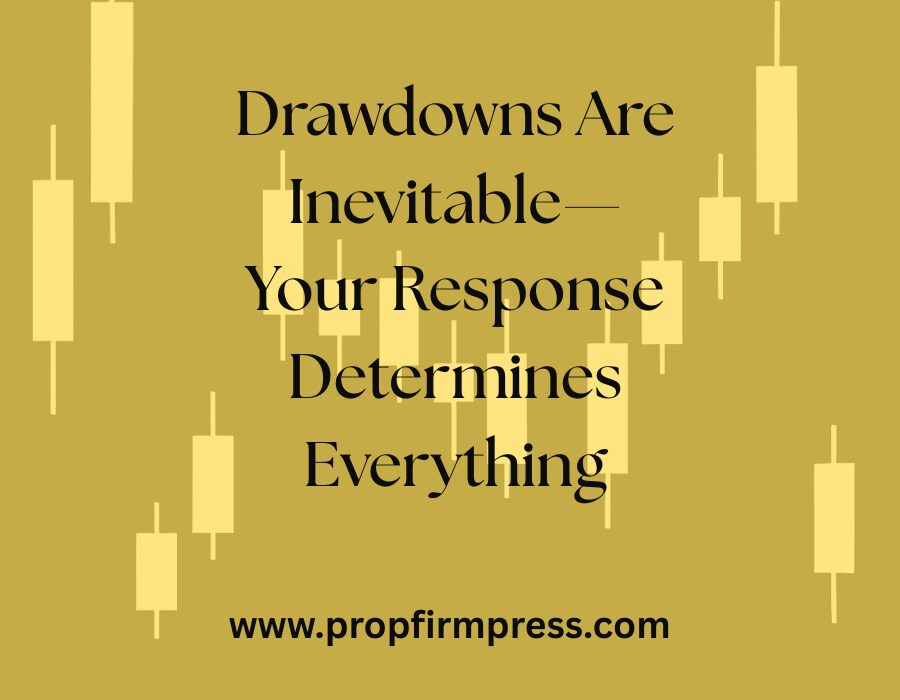Drawdowns Are Inevitable—Your Response Determines Everything
Every trader—whether a beginner or a seasoned funded professional—will face drawdowns. They are part of the trading landscape. What separates traders who survive from those who blow their accounts is how they handle those drawdowns. If you’re trading with The Legends Trading, Instant Funding, or any other prop firm, managing equity slumps is one of the most critical skills you must develop. Prop firm rules are unforgiving, so learning to navigate loss periods with discipline is non-negotiable.
What Is a Drawdown?
A drawdown is a reduction in account equity from a peak to a trough, typically expressed as a percentage. For example, if your trading account hits $5,000 and drops to $4,500, you’ve experienced a 10% drawdown.
There are two key types of drawdowns:
- Equity Drawdown: The real-time reduction in equity as trades fluctuate in value
- Closed-Trade Drawdown: The actual realized losses after trades are closed
Prop firms usually calculate drawdown based on closed trades or a combination of both, depending on their rules. Always verify the specifics in the firm’s evaluation guidelines.
Why Drawdowns Are Dangerous in Prop Firm Challenges
Prop firms like Lucid Trading and Funded Futures Network have strict daily loss and overall drawdown limits. If you hit those limits, your account is terminated—no exceptions. Even a small drawdown can jeopardize your evaluation.
For example, if your drawdown limit is 4% and you take three consecutive 2% losses, you’re already breaching risk parameters. This is why handling drawdowns calmly and proactively is so important.
Common Emotional Reactions to Drawdowns
- Revenge Trading: Trying to win back losses with oversized positions
- Freezing: Becoming paralyzed, unable to take new trades
- System Hopping: Changing strategies mid-drawdown
- Overanalyzing: Reading too much into short-term variance
Each of these behaviors can make the situation worse. Recognizing your default response to losses is the first step in creating a better system for managing them.
Rules to Follow During a Drawdown
1. Reduce Position Size
The most immediate fix is to scale down your trade size. Lower risk reduces the emotional weight of every trade and buys you time to stabilize. Instead of risking 1% per trade, drop to 0.25% until consistency returns.
2. Pause After Consecutive Losses
Set a rule: if you lose three trades in a row, stop trading for the day. This limits impulsive decisions made under stress and creates space for reflection.
3. Journal Extensively
Write down not just what happened, but how you felt. Document each losing trade with entry/exit, rationale, and emotion. Use tools from Prop Firm Press to structure your notes and find patterns in your mistakes.
4. Revisit Your Strategy
During a drawdown, it’s tempting to overhaul your system. Instead, revisit the backtest. Ask:
- Has this happened before?
- How long did the last drawdown last?
- What adjustments are historically supported?
Only make changes that are data-driven, not emotionally motivated.
5. Shorten Trading Timeframes
During tough periods, some traders benefit from reducing exposure. Consider trading only one session (e.g., NY open) or one hour a day until confidence rebuilds.
6. Create a Recovery Plan
Your drawdown recovery plan might include:
- Daily loss cap of 1%
- Max 2 trades per session
- Mandatory journaling before next day
- Weekly performance review
This creates structure in what feels like chaos.
How to Stay Mentally Grounded
Drawdowns affect confidence. Here are mental techniques that work:
- Affirmations: Repeat statements like “Drawdowns are part of the game” and “I trade probabilities, not guarantees.”
- Daily Walks: Physical activity clears emotional fog
- Pre-trade Routine: Reset your focus before every session
Use the Prop Firm’s Tools
Some platforms like Prop Shop Traders or Blue Guardian offer dashboards with performance stats. Use these to spot slumps early, not after it’s too late.
Look for trends like:
- Overtrading after losses
- Drop in average trade quality
- Increased size after wins or losses
When to Take a Full Break
If a drawdown continues for more than 10–15 trades with no improvement, take a full break for 3–5 days. Use this time to re-read your journal, refresh your mindset, and return with a clean slate.
The Goal Is Survival, Then Thriving
Traders who survive drawdowns with minimal damage position themselves to thrive during good market conditions. Protecting your equity, staying emotionally grounded, and following a plan will ensure that drawdowns become temporary setbacks—not account-ending disasters.
